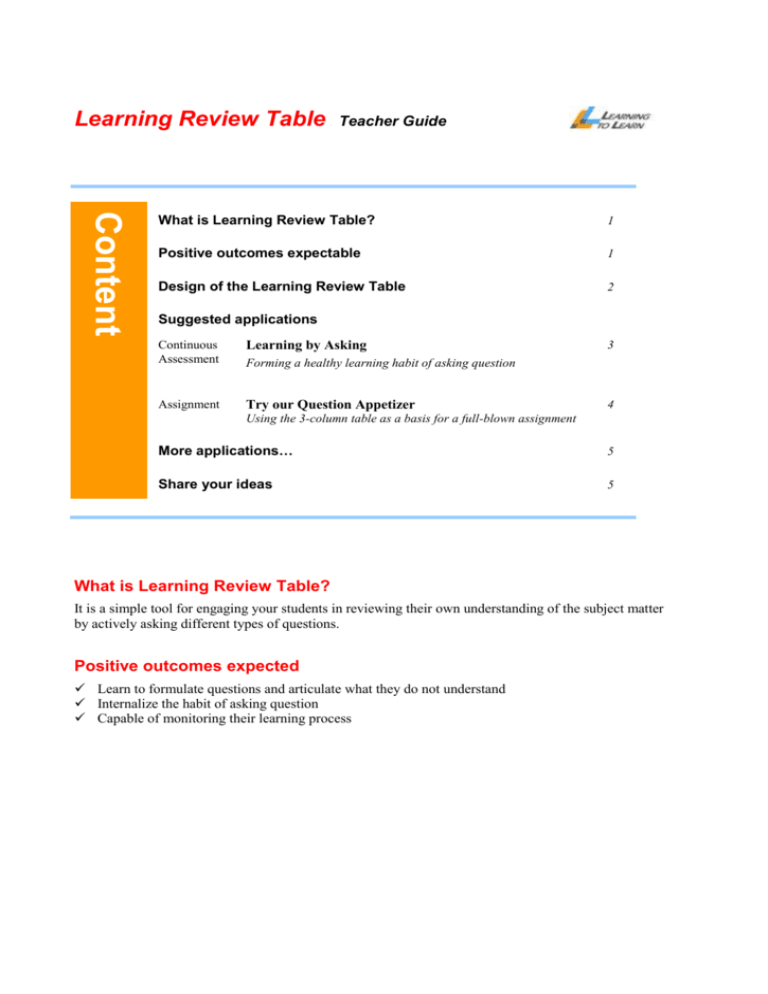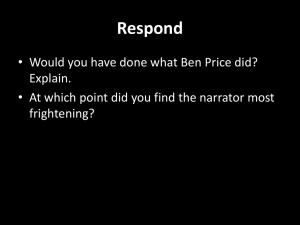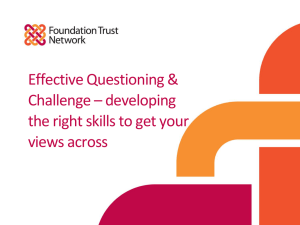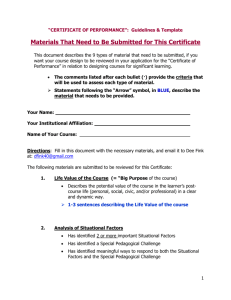3-Column Table Teacher Guide
advertisement

Learning Review Table Teacher Guide Content What is Learning Review Table? 1 Positive outcomes expectable 1 Design of the Learning Review Table 2 Suggested applications Continuous Assessment Learning by Asking Assignment Try our Question Appetizer 3 Forming a healthy learning habit of asking question 4 Using the 3-column table as a basis for a full-blown assignment More applications… 5 Share your ideas 5 What is Learning Review Table? It is a simple tool for engaging your students in reviewing their own understanding of the subject matter by actively asking different types of questions. Positive outcomes expected Learn to formulate questions and articulate what they do not understand Internalize the habit of asking question Capable of monitoring their learning process Learning Review Table Design of the Learning Review Table The 3-column Table contains features which guide students to proceed through the following steps: Column 1. Write questions on things that the student can understand from the text / lecture. Column 2. Write questions on things from the text / lecture that the student do not understand Rationale: Column 1 and 2 engage students in reflecting over their learning to distinguish between what they know and what they do not. Such awareness is essential in developing a selfconscious and motivated learner. Column 3. Write questions on things which are related to the topic, but are not discussed in the text / lecture which the students is interested to know Rationale: It stimulates students to think beyond what is given and to see relationships among various topics Some generic question stems to help students to start off! Learning Review Table 2 Learning Review Table Continuous Assessment Learning by Asking The ability of asking question does not come naturally to students. Therefore, there is a need to provide an ample amount of opportunities for students to polish the skill up. Practice makes perfect! Sample Instructions for Students: Instructions This exercise will count for x% of your final grade. In this exercise you are required to: 1. Complete necessary readings, and critically review your understanding of topics 2. Write questions about the topic for the Learning Review Table Date of submission: XX / XX /200X Topic covered in this exercise: GradingXXXXX, YYYYY, ZZZZZ By completing this exercise, you willSee develop your abilities in: Guidelines for Grading 1. Preparing or reviewing the material in serious and critical manner 2. Specifying and articulating what you do and do not understand 3. Knowing how to monitor your study and learning How to get an A in this exercise? The grade you deserve… Things you need to do to achieve this grade… A The questions you asked have demonstrated a diligent effort to work out the relationship among the concepts within a topic, and a creative and logical attempt to link the topic to other areas. B The question you asked show an effort to work out the relationship among the concepts within a topic C You have just throw in everything you can think of about the topic without considering the connections and relationships among things D You just hand in the exercise, and don’t give a thought on what you’ve written! F (Fail) Do nothing, don’t hand in the exercise, then you will get what you deserve! But are you sure you want this? 3 Learning Review Table Assignment Try our Question Appetizer You might want to ask your students to go beyond from knowing how to ask questions. In this case, you can use our 3-column table as a basis of a graded assignment. Sample Instructions for Students: Instructions This assignment will count for x% of your final grade. In this assignment you are required to: 1. Write questions for the three categories in the Learning Review Table 2. Provide answer to one (or more, as specified by the teacher) of the questions, which you put down in the first column 3. Propose a plan of further learning for one (or more, as specified by you) of the questions, which you put down in the second or third column. Date of submission: XX / XX / 200X Topic covered in this assignment: XXXXX, YYYYY, ZZZZZ By completing this exercise, you will develop your ability in: 1. Asking quality questions, and finding ways to answer them 2. Localizing your weakness(es), and tailor-making methods to improve yourself 3. Developing an attitude of taking charge of your own learning How to get an A in this assignment? What to ask and how to answer… What learning plans to propose… A You ask a list of very challenging question based on what you know from the topic, and make a courageous attempt to answer it /them in a very comprehensive way. On top of it, you provide original ideas, views and solutions to the question which demonstrate a clear move to go beyond from the current topic of interest You can identify the exact area of interest you need to work on. Moreover, you have the foresight on what other areas to work on in order to allow yourself to go beyond from your existing knowledge base B You ask a list of very thoughtful question based on what you know from the topic, and provide answers showing your understanding and the ability to see connections among concepts in the topic You can identify the next thing you need to do, and can provide a very specific and doable plan C You make some effort to come up with the questions. However, you don’t have an overall picture of all the questions you ask, and you may not know how to answer them comprehensively. Take a couple of more hours to revise the material definitely help! You have a faint clue of what to do next The grade you deserve… D F (Fail) For the sake of completion, you just throw in a few 5W questions (since you think these type of questions are easy to answer!), without giving any careful considerations of why are you asking them You only put down some very generic and vague suggestions, such as improve my time management skills and read widely Do nothing, don’t hand in the assignment, then you will get what you deserve. But are you sure you want to do this? 4 Learning Review Table More applications… The Learning Review Table is ideal for many settings in your teaching, such as in helping your students to prepare or review a lecture, and alleviate the dead-air tension in a tutorial session. Here are a few scenarios of how it is used: A teacher inserted a brief break in his lecture to ask students to think of questions for the first two columns in the worksheet, so that students could have an instant review and quick-fix of their lecture notes for the previous 30 minutes of the lecture. After the 5 to 10 minutes break, the teacher asked students to volunteer a few questions in each column, and compiled them on the board. The teacher could then identify some common misunderstandings and concerns of students, and clarify these right on the spot, so that students would not have a chance to have any left-over uncertainties when stepping out of the lecture hall. Another teacher / tutor use the Learning Review Table to jump-start students for latter discussion. Once students have generated a few questions, the tension of silence can be transmuted into an insightful inter-flow of questions and answers. In the above scenarios, the teacher uses the format of the Learning Review Table as a brief in-class activity. However, hectic teaching conditions do not always allow the luxury to include a class activity. Alternatively, the Learning Review Table can also be used flexibly as an aiding tool for students’ preparation or revision, see the following scenario: A teacher distributed a set of Learning Review Table worksheets to students at the beginning of the course. He briefed his students of when and how to use this worksheet—they can use it either to prepare or review a topic. He also emphasized to them that the submission of the worksheets is completely voluntary. By introducing students such an opportunity to ask questions regularly, the importance of closely monitoring one’s study will be properly instilled. Students would no longer start to think of what they do not understand only when it comes to the time of tests and exams. Our Learning Review Table marks the first step of engaging students to ask question. Asking quality question takes practice and requires proper guidance. See our QUESTION-ASKING GUIDE, which is specifically designed to enhance students’ ability in producing better questions, in terms of depth and extendedness. Share your ideas Send us your experience of using this tool to share with your fellow teacher! Click here or visit our website to send us an email. 5







